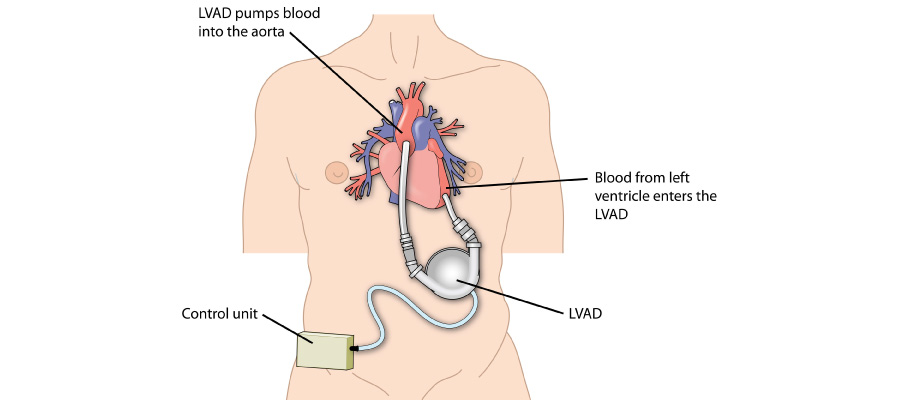LVAD (Left Ventricular Assist Device): A Bridge To Heart Transplant
"A Heartmate to tackle end-stage heart failure #My2ndHeartBeat!"
Despite the introduction of highly effective heart failure medical therapies such as cardiac resynchronization and cardiac transplantation that reduce mortality and improve cardiac function with quality of life, there remains a large number of patients who do not respond to these treatment modalities or suffer sickness due to unavailability of a donor. For these patients, Left Ventricular Assist Devices (LVADs) offer an alternative that can improve survival as well as the quality of life.
As per reports, over 28,000 LVADs have been implanted globally till date, and 10,000 patients are currently using the device for more than 10 years.
LVADs can be the best alternative to cardiac transplantation that may provide long term survival in many patients.

Who is the right candidate for LVAD surgery?
LVAD is a treatment option for patients with end-stage heart failure. Other factors that make it a suitable choice for patients include:
- Severe chronic health condition or elderly who can’t endure a major heart surgery
- Patients who cannot wait anymore for a heart donor
- Improper BMI to undergo a heart transplant surgery
- Someone with an organ rejection after a heart transplant
- Someone who suffered a major heart attack and has no other treatment option
If you are diagnosed with advanced heart failure, LVAD can be a good option. You will need to be evaluated to determine whether the treatment option is appropriate for you.
The cardio team will carefully examine you and would conduct a few medical exams including:
- X-ray
- Electrocardiogram
- Bloodwork
- Echocardiogram
- Metabolic stress test
- Heart catheterization
LVAD is not recommended for people who have:
- Kidney failure
- Serious brain injury
- Clotting problems
- Liver disease
- Lung disease
- Severe infections
How to detoxify your liver?
How to detoxify your liver? The LVAD is a battery-operated, mechanical pump device that serves as a partial artificial heart. This is surgically implanted and is an open procedure that helps the left ventricle pump oxygen-rich blood to the aorta and the body. It helps in maintaining the heart's capacity to pump effectively on its own. For patients awaiting heart transplantation, those who aren't candidates for heart transplantation (destination therapy), and those with cardiac diseases such as severe heart failure, myocarditis, and cardiomyopathy, this device can be the bridge to heart transplantation or as a long-term treatment. In other words, by pumping oxygen-rich blood, LVAD improves the quality of life.
Life after LVAD
Once your LVAD is implanted, you will be constantly connected to the LVAD external controller and power source. When you are active, your gadget will be powered by a battery, and when you are asleep, it will be powered by electricity. As an emergency backup, you should keep an extra controller and fully charged batteries (and power cords, if applicable) on hand at all times. You must remember to bring this back-up equipment with you anytime you leave the house
Life-Changing Technology
LVAD patients are discharged from the hospital 14 days after the surgery and can return to their normal lives after two months of the surgery. Those who used to get tired while cooking or talking are now able to resume driving or even cross-country travel. Symptoms of heart failure, such as fluid retention and impaired organ function, can be resolved with LVAD!
Ways to Stay Healthy Post LVAD
It is extremely important to make healthy lifestyle changes before and after the LVAD placement. Quit smoking, eat healthily, avoid alcohol, and engage in moderate exercise. Most importantly, continue to visit your doctor on a routine basis.
Almost everyone who gets this device implanted easily adopts to lifestyle changes in order to live a healthier and longer life.
Make an Appointment Or Call us at 04068334455
A Team That Cares at Medicover
Apart from surgery, there is a risk of infection, stroke, bleeding, or the need for a device modification. Patients at Medicover Hospitals are evaluated thoroughly and the team helps them balance the risks of implanting the device with the risks of heart failure progression.
At Medicover Hospitals, we deliver a team-oriented and comprehensive approach to heart disease patients with a high level of technical expertise and experience. Our comprehensive heart failure services include medical therapy, heart transplantation, LVAD, ambulatory balloon pumps, and ECMO, providing quality and affordable healthcare to everyone.
We take pride in being one of foremost multi-speciality healthcare providers in India serving both domestic and international patients.
Give Your Heart a Boost!

